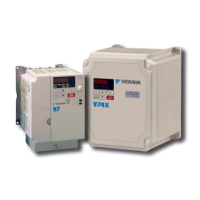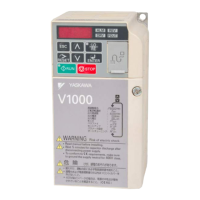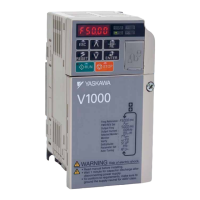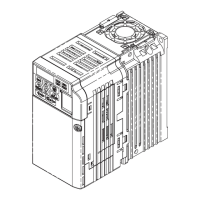No. Name
User
Setting
H3-03 Terminal A1 Gain Setting
H3-04 Terminal A1 Bias Setting
H3-09 Terminal A2 Signal Level Selection
H3-10 Terminal A2 Function Selection
H3-11 Terminal A2 Gain Setting
H3-12
Frequency Reference (Current) Terminal A2
Input Bias
H3-13 Analog Input Filter Time Constant
H3-14 Analog Input Terminal Enable Selection
H3-16 Terminal A1 Offset
H3-17 Terminal A2 Offset
H4-01
Multi-Function Analog Output (Terminal
AM Monitor Selection)
H4-02
Multi-Function Analog Output (Terminal
AM Output Gain)
H4-03
Multi-Function Analog Output (Terminal
AM Output Bias)
H5-01 Drive Node Address
H5-02 Communication Speed Selection
H5-03 Communication Parity Selection
H5-04
Stopping Method After Communication
Error
H5-05 Communication Fault Detection Selection
H5-06 Drive Transmit Wait Time
H5-07 RTS Control Selection
H5-09 CE Detection Time
H5-10
Unit Selection for MEMOBUS/Modbus
Register 0025H
H5-11 Communications ENTER Function Selection
H5-12 Run Command Method Selection
H6-01
(Terminal RP) Pulse Train Input Function
Selection
H6-02 Pulse Train Input Scaling
H6-03 Pulse Train Input Gain
H6-04 Pulse Train Input Bias
H6-05 Pulse Train Input Filter Time
H6-06 (Terminal MP) Pulse Train Monitor Selection
H6-07 Pulse Train Monitor Scaling
L1-01 Motor Overload Protection Selection
L1-02 Motor Overload Protection Time
L1-03
Motor Overheat Alarm Operation Selection
(PTC input)
L1-04
Motor Overheat Fault Operation Selection
(PTC input)
L1-05
Motor Temperature Input Filter Time (PTC
input)
L1-13
Continuous Electrothermal Operation
Selection
L1-22 Leakage Current Filter Time Constant 1
L1-23 Leakage Current Filter Time Constant 2
L2-01 Momentary Power Loss Operation Selection
L2-02 Momentary Power Loss Ride-Thru Time
L2-03
Momentary Power Loss Minimum Baseblock
Time
L2-04
Momentary Power Loss Voltage Recovery
Ramp Time
L2-05 Undervoltage Detection Level (Uv)
L2-06 KEB Deceleration Time
No. Name
User
Setting
L2-07 Momentary Power Loss Ride-Thru Time
L2-08 Minimum Frequency Gain at KEB Start
L2-11 Desired DC Bus Voltage During KEB
L3-01
Stall Prevention Selection during
Acceleration
L3-02 Stall Prevention Level during Acceleration
L3-03 Stall Prevention Limit during Acceleration
L3-04
Stall Prevention Selection during
Deceleration
L3-05 Stall Prevention Selection during Run
L3-06 Stall Prevention Level during Run
L3-11 ov Suppression Function Selection
L3-17
Overvoltage Suppression and Deceleration
Stall (Desired DC Bus Voltage during Motor
Stall)
L3-20 Main Power Circuit Voltage Adjustment Gain
L3-21 Accel/Decel Rate Calculation Gain
L3-22
Deceleration Time at Stall Prevention during
Acceleration
L3-23
Automatic Reduction Selection for Stall
Prevention during Run
L3-24
Motor Acceleration Time for Inertia
Calculations
L3-25 Load Inertia Ratio
L4-01 Speed Agreement Detection Level
L4-02 Speed Agreement Detection Width
L4-03 Speed Agreement Detection Level (+/-)
L4-04 Speed Agreement Detection Width (+/-)
L4-05
Frequency Reference Loss Detection
Selection
L4-06 Frequency Reference at Reference Loss
L4-07 Frequency Detection Conditions
L4-08 Speed Agreement Detection Conditions
L5-01 Number of Auto Restart Attempts
L5-02 Auto Restart Operation Selection
L5-04 Fault Reset Interval Time
L5-05 Fault Reset Operation Selection
L6-01 Torque Detection Selection 1
L6-02 Torque Detection Level 1
L6-03 Torque Detection Time 1
L6-04 Torque Detection Selection 2
L6-05 Torque Detection Level 2
L6-06 Torque Detection Time 2
L6-08 Mechanical Weakening Detection Operation
L6-09
Mechanical Weakening Detection Speed
Level
L6-10 Mechanical Weakening Detection Time
L6-11 Mechanical Weakening Detection Start Time
L7-01 Forward Torque Limit
L7-02 Reverse Torque Limit
L7-03 Forward Regenerative Torque Limit
L7-04 Reverse Regenerative Torque Limit
L7-06 Torque Limit Integral Time Constant
L7-07
Torque Limit Control Method Selection
during Accel/Decel
E.3 User Setting Table
460
YASKAWA ELECTRIC SIEP C710606 16C YASKAWA AC Drive – V1000 Technical Manual
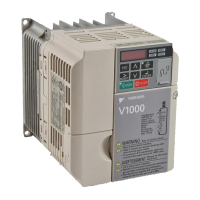
